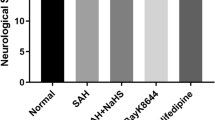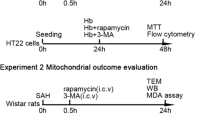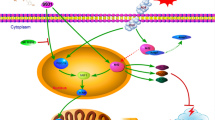Abstract
Previous studies have shown that mitochondrial Ca2+ is undertaken by mitochondrial calcium uniporter (MCU), and its accumulation is associated with the development of many diseases. However, little was known about the role of MCU in early brain injury (EBI) after subarachnoid hemorrhage (SAH). MCU can be opened by spermine under a physiological condition and inhibited by ruthenium red (RR). Herein, we investigated the effects of RR and spermine to reveal the role of MCU in SAH animal model. The data obtained with biochemical and histological assays showed that mitochondrial Ca2+ concentration was significantly increased in the temporal cortex of rats 1, 2, and 3 days after SAH, consistent with constant high levels of cellular Ca2+ concentration. In agreement with the observation in the acute phase, SAH rats showed an obvious increase of reactive oxygen species (ROS) level and decrease of ATP production. Blockage of MCU prevented Ca2+ accumulation, abated the level of oxidative stress, and improved the energy supply. Translocation of cytochrome c, increased cleaved caspase-3, and a large amount of apoptotic cells after SAH were reversed by RR administration. Surprisingly, exogenous spermine did not increase cellular Ca2+ concentration, but lessened the Ca2+ accumulation after SAH to benefit the rats. Taken together, our results demonstrated that blockage of MCU or prevention of Ca2+ accumulation after SAH is essential in EBI after SAH. These findings suggest that MCU is considered to be a therapeutic target for patients suffering from SAH.









Similar content being viewed by others
References
Green DM, Burns JD, DeFusco CM (2013) ICU management of aneurysmal subarachnoid hemorrhage. J Intensive Care Med 28:341–354
American Heart Association Stroke C, Council on Cardiovascular R, Intervention, Council on Cardiovascular N, Council on Cardiovascular S, Anesthesia, Council on Clinical C, Connolly ES Jr, Rabinstein AA, Carhuapoma JR, Derdeyn CP, Dion J, Higashida RT, Hoh BL, Kirkness CJ, Naidech AM, Ogilvy CS, Patel AB, Thompson BG, Vespa P (2012) Guidelines for the management of aneurysmal subarachnoid hemorrhage: a guideline for healthcare professionals from the American Heart Association/American Stroke Association. Stroke 43:1711–1737
Topkoru BC, Altay O, Duris K, Krafft PR, Yan J, Zhang JH (2013) Nasal administration of recombinant osteopontin attenuates early brain injury after subarachnoid hemorrhage. Stroke 44:3189–3194
Macdonald RL, Higashida RT, Keller E, Mayer SA, Molyneux A, Raabe A, Vajkoczy P, Wanke I, Bach D, Frey A, Marr A, Roux S, Kassell N (2011) Clazosentan, an endothelin receptor antagonist, in patients with aneurysmal subarachnoid haemorrhage undergoing surgical clipping: a randomised, double-blind, placebo-controlled phase 3 trial (CONSCIOUS-2). Lancet Neurol 10:618–625
Vergouwen MD, Ilodigwe D, Macdonald RL (2011) Cerebral infarction after subarachnoid hemorrhage contributes to poor outcome by vasospasm-dependent and -independent effects. Stroke 42:924–929
Cahill J, Zhang JH (2009) Subarachnoid hemorrhage: is it time for a new direction? Stroke 40:S86–S87
Sehba FA, Hou J, Pluta RM, Zhang JH (2012) The importance of early brain injury after subarachnoid hemorrhage. Prog Neurobiol 97:14–37
Nicchitta CV, Williamson JR (1984) Spermine. A regulator of mitochondrial calcium cycling. J Biol Chem 259:12978–12983
Kirichok Y, Krapivinsky G, Clapham DE (2004) The mitochondrial calcium uniporter is a highly selective ion channel. Nature 427:360–364
McCormack JG, Halestrap AP, Denton RM (1990) Role of calcium ions in regulation of mammalian intramitochondrial metabolism. Physiol Rev 70:391–425
Peng TI, Jou MJ (2010) Oxidative stress caused by mitochondrial calcium overload. Ann N Y Acad Sci 1201:183–188
Di Lisa F, Bernardi P (2009) A CaPful of mechanisms regulating the mitochondrial permeability transition. J Mol Cell Cardiol 46:775–780
Owens K, Park JH, Schuh R, Kristian T (2013) Mitochondrial dysfunction and NAD(+) metabolism alterations in the pathophysiology of acute brain injury. Transl Stroke Res 4:618–634
O’Rourke B (2000) Pathophysiological and protective roles of mitochondrial ion channels. J Physiol 529:23–36
Orrenius S, Zhivotovsky B, Nicotera P (2003) Regulation of cell death: the calcium-apoptosis link. Nat Rev Mol Cell Biol 4:552–565
Zhao QW, Li S, Wang Y, Li P, Guo S, Yao YR (2013) The role of the mitochondrial calcium uniporter in cerebral ischemia/reperfusion injury in rats involves regulation of mitochondrial energy metabolism. Mol Med Rep 7:1073–1080
American Heart Association Stroke C, Council on Cardiovascular R, Intervention, Council on Cardiovascular N, Council on Cardiovascular S, Anesthesia, Council on Clinical C, Connolly ES Jr, Rabinstein AA, Carhuapoma JR, Derdeyn CP, Dion J, Higashida RT, Hoh BL, Kirkness CJ, Naidech AM, Ogilvy CS, Patel AB, Thompson BG, Vespa P (2012) Guidelines for the management of aneurysmal subarachnoid hemorrhage: a guideline for healthcare professionals from the American Heart Association/American Stroke Association. Stroke 43:1711–1737
Liang N, Wang P, Wang S, Li S, Li Y, Wang J, Wang M (2014) Role of mitochondrial calcium uniporter in regulating mitochondrial fission in the cerebral cortexes of living rats. J Neural Transm 121:593–600
Prunell GF, Mathiesen T, Svendgaard NA (2002) A new experimental model in rats for study of the pathophysiology of subarachnoid hemorrhage. Neuroreport 13:2553–2556
Sun Q, Dai Y, Zhang X, Hu YC, Zhang D, Li W, Zhang XS, Zhu JH, Zhou ML, Hang CH (2013) Expression and cell distribution of myeloid differentiation primary response protein 88 in the cerebral cortex following experimental subarachnoid hemorrhage in rats: a pilot study. Brain Res 1520:134–144
Dai Y, Sun Q, Zhang X, Hu Y, Zhou M, Shi J (2014) Cyclosporin A ameliorates early brain injury after subarachnoid hemorrhage through inhibition of a Nur77 dependent apoptosis pathway. Brain Res 1556:67–76
Yamaguchi M, Zhou C, Nanda A, Zhang JH (2004) Ras protein contributes to cerebral vasospasm in a canine double-hemorrhage model. Stroke 35:1750–1755
Zhuang Z, Zhou ML, You WC, Zhu L, Ma CY, Sun XJ, Shi JX (2012) Hydrogen-rich saline alleviates early brain injury via reducing oxidative stress and brain edema following experimental subarachnoid hemorrhage in rabbits. BMC Neurosci 13:47
Cosentino K, Garcia-Saez AJ (2014) Mitochondrial alterations in apoptosis. Chem Phys Lipids 181:62–75
Ricci JE, Gottlieb RA, Green DR (2003) Caspase-mediated loss of mitochondrial function and generation of reactive oxygen species during apoptosis. J Cell Biol 160:65–75
Gaetani P, Pasqualin A, Rodriguez y Baena R, Borasio E, Marzatico F (1998) Oxidative stress in the human brain after subarachnoid hemorrhage. J Neurosurg 89:748–754
Nina P, Schisano G, Chiappetta F, Luisa Papa M, Maddaloni E, Brunori A, Capasso F, Corpetti MG, Demurtas F (2001) A study of blood coagulation and fibrinolytic system in spontaneous subarachnoid hemorrhage. Correlation with hunt-hess grade and outcome. Surg Neurol 55:197–203
Mehta A, Prabhakar M, Kumar P, Deshmukh R, Sharma PL (2013) Excitotoxicity: bridge to various triggers in neurodegenerative disorders. Eur J Pharmacol 698:6–18
Patron M, Raffaello A, Granatiero V, Tosatto A, Merli G, De Stefani D, Wright L, Pallafacchina G, Terrin A, Mammucari C, Rizzuto R (2013) The mitochondrial calcium uniporter (MCU): molecular identity and physiological roles. J Biol Chem 288:10750–10758
Ostrowski RP, Colohan AR, Zhang JH (2006) Molecular mechanisms of early brain injury after subarachnoid hemorrhage. Neurol Res 28:399–414
Zhang SZ, Gao Q, Cao CM, Bruce IC, Xia Q (2006) Involvement of the mitochondrial calcium uniporter in cardioprotection by ischemic preconditioning. Life Sci 78:738–745
Yang X, Wang B, Zeng H, Cai C, Hu Q, Cai S, Xu L, Meng X, Zou F (2014) Role of the mitochondrial Ca uniporter in Pb-induced oxidative stress in human neuroblastoma cells. Brain Res 1575:12–21. doi:10.1016/j.brainres.2014.05.032
Kalac P (2014) Health effects and occurrence of dietary polyamines: a review for the period 2005–mid 2013. Food Chem 161:27–39
Mozdzan M, Szemraj J, Rysz J, Stolarek RA, Nowak D (2006) Anti-oxidant activity of spermine and spermidine re-evaluated with oxidizing systems involving iron and copper ions. Int J Biochem Cell Biol 38:69–81
Premkumar K, Bowlus CL (2004) Ascorbic acid does not increase the oxidative stress induced by dietary iron in C3H mice. J Nutr 134:435–438
Salvi M, Toninello A (2004) Effects of polyamines on mitochondrial Ca(2+) transport. Biochim Biophys Acta 1661:113–124
Hubschmann OR, Nathanson DC (1985) The role of calcium and cellular membrane dysfunction in experimental trauma and subarachnoid hemorrhage. J Neurosurg 62:698–703
Wang J, Ohta S, Sakaki S, Araki N, Matsuda S, Sakanaka M (1994) Changes in Ca(++)-ATPase activity in smooth-muscle cell membranes of the canine basilar artery with experimental subarachnoid hemorrhage. J Neurosurg 80:269–275
Friedrich V, Flores R, Sehba FA (2012) Cell death starts early after subarachnoid hemorrhage. Neurosci Lett 512:6–11
Acknowledgments
We would like to thank Dr. Chunxi Wang, Guangbin Xie, and Yuqiu Lu for their technical assistance. This study was supported by the National Natural Science Foundation, China (nos. 81371294, 31071085, and 31371060).
Author information
Authors and Affiliations
Corresponding authors
Rights and permissions
About this article
Cite this article
Yan, H., Zhang, D., Hao, S. et al. Role of Mitochondrial Calcium Uniporter in Early Brain Injury After Experimental Subarachnoid Hemorrhage. Mol Neurobiol 52, 1637–1647 (2015). https://doi.org/10.1007/s12035-014-8942-z
Received:
Accepted:
Published:
Issue Date:
DOI: https://doi.org/10.1007/s12035-014-8942-z




